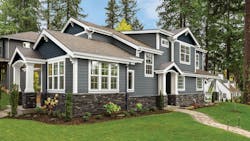Vinyl Siding: A Surprising Way to Go Green
Most people don’t consider vinyl an eco-friendly building product, but data show it actually is. There are misconceptions that vinyl siding doesn’t have sustainable design, production, or operations. But vinyl outperforms almost all other common cladding materials, including fiber cement and brick, in total environmental impact.
While the classic look of wood is forever timeless, new developments in design allow vinyl siding to look and feel like real wood, down to the actual grain. With vinyl, you can eliminate the cost and maintenance of wood and choose a sustainable, durable, and affordable alternative. If you, your company, or your customers are dedicated to greener construction and building practices, then vinyl siding is for you.
BENEFITS OF VINYL SIDING
Less Waste
From production to construction, vinyl siding produces less waste than other building materials, such as brick and cement. Vinyl siding products require minimal raw material. They also require less water and energy to produce than other building materials.
Lower Impact
Vinyl siding also maintains a low environmental impact over its lifespan. The National Institute of Standards and Technology (NIST) developed Building for Environmental and Economic Sustainability (BEES) software to measure specific environmental concerns such as air pollution, acidification, and global warming potential in the environmental life cycle of products.
Throughout its life cycle, vinyl releases significantly fewer toxic chemicals into the environment than other siding materials and has a lower overall environmental impact. Vinyl does not need to be restained or repainted during its life span.
Compared to vinyl siding, construction materials like fiber cement contribute 4x to global warming potential, 2x to acidification, and over 3x to air pollution. Compared to other common sidings, vinyl performs amazingly well. According to the NIST, vinyl has a lower environmental impact than brick, and even rivals some wood siding.
Westlake Royal Building Products uses PVC resin as the backbone of Royal and Exterior Portfolio vinyl siding. This is derived from components in nature, including 57% salt as well as natural gas, that make PVC weather-resistant, chemically stable, and lightweight. Vinyl’s light weight also means it travels with less energy consumption throughout the value chain.
Recyclable
Vinyl siding is recyclable with post-consumer recycling, post-industrial recycling, and closed-loop recycling, meaning every part of its production and lifespan lends it to being easily reused.
Recycling reduces waste disposal and extraction of new materials while reducing landfill accumulation and incineration. Both lead to an increase in greenhouse gas emissions. Because of the nature of PVC, vinyl is a thermoplastic that can be ground up repeatedly, re-melted, and formed into various new products even after the life expiration of the original product.
Last year, Westlake Royal Building Products recycled more than 40 million pounds of PVC across its vinyl siding and shake plants. Almost all of our internally generated waste is re-used into our operation, making it very efficient.
Longevity
The longevity of vinyl siding is part of what makes it so eco-friendly. Although recycling is an important component of sustainability, vinyl lasts such a long time it is unlikely to end up in the waste stream anytime soon. Many warranties on vinyl siding last for 40 years or more, meaning it doesn’t have to be ripped out and replaced very often.
Not only is vinyl long-lasting, but it’s low maintenance. Exterior siding that requires less care saves resources and reduces emissions and chemicals.
Resources for Building Pros
The Vinyl Siding Institute recently published three Environmental Product Declarations (EPDs) outlining the life cycle of polymeric siding. The EPDs were conducted via a third party and were developed in accordance with standards developed by the International Organization for Standardization (ISO).
The three EPDs—covering industry-averaged vinyl siding, insulated vinyl siding, and polypropylene siding—outline the environmental impact of the product over the course of its life, including raw material extraction and transport, manufacturing, and waste generation. By offering data in a transparent and standardized way, EPDs allow product specifiers to make apples-to-apples comparisons between different products and material types, providing transparency and authenticity in sustainability research.
However, these newest EPDs forgo the typical numbers-heavy report that can feel too complex and unapproachable. Instead, VSI says the marketing-style guides feature easy-to-read text and graphics, along with an organized chronology of features and benefits that make the data more accessible and understandable for both pros and their customers.
Thanks to innovative technology and sustainable practices, PVC vinyl siding is ideal for giving homeowners the aesthetic and performance they are looking for, while offering the peace of mind that our products were purpose-built to support a sustainable alternative and future.
Westlake Royal Building Products’ portfolio of siding, trim, stone, and roofing brands offers a diversity of styles and options to meet your buyers’ needs. Click to explore:
